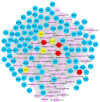Identification of Key Metabolites for Acute Lung Injury in Patients with Sepsis
- PMID: 30847314
- PMCID: PMC6401565
Identification of Key Metabolites for Acute Lung Injury in Patients with Sepsis
Abstract
Background: The study aimed to detect critical metabolites in acute lung injury (ALI).
Methods: A comparative analysis of microarray profile of patients with sepsis-induced ALI compared with sepsis patients with was conducted using bioinformatic tools through constructing multi-omics network. Multi-omics composite networks (gene network, metabolite network, phenotype network, gene-metabolite association network, phenotype-gene association network, and phenotype-metabolite association network) were constructed, following by integration of these composite networks to establish a heterogeneous network. Next, seed genes, and ALI phenotype were mapped into the heterogeneous network to further obtain a weighted composite network. Random walk with restart (RWR) was used for the weighted composite network to extract and prioritize the metabolites. On the basis of the distance proximity among metabolites, the top 50 metabolites with the highest proximity were identified, and the top 100 co-expressed genes interacted with the top 50 metabolites were also screened out.
Results: Totally, there were 9363 nodes and 10,226,148 edges in the integrated composite network. There were 4 metabolites with the scores > 0.009, including CHITIN, Tretinoin, sodium ion, and Celebrex. Adenosine 5'-diphosphate, triphosadenine, and tretinoin had higher degrees in the composite network and the co-expressed network.
Conclusion: Adenosine 5'-diphosphate, triphosadenine, and tretinoin may be potential biomarkers for diagnosis and treatment of ALI.
Keywords: Acute lung injury; Differentially expressed genes; Metabolites; Multi-omics network.
Conflict of interest statement
Conflict of Interest The authors declare that there is no conflict of interest.
Figures


Similar articles
-
Prioritization of candidate metabolites for postmenopausal osteoporosis using multi-omics composite network.Exp Ther Med. 2019 Apr;17(4):3155-3161. doi: 10.3892/etm.2019.7310. Epub 2019 Feb 26. Exp Ther Med. 2019. PMID: 30936988 Free PMC article.
-
Deciphering the Core Metabolites of Fanconi Anemia by Using a Multi-Omics Composite Network.J Microbiol Biotechnol. 2022 Mar 28;32(3):387-395. doi: 10.4014/jmb.2106.06027. J Microbiol Biotechnol. 2022. PMID: 34954697 Free PMC article.
-
Combined metabolic, phenomic and genomic data to prioritize atrial fibrillation-related metabolites.Exp Ther Med. 2019 May;17(5):3929-3934. doi: 10.3892/etm.2019.7443. Epub 2019 Mar 26. Exp Ther Med. 2019. PMID: 31007735 Free PMC article.
-
Identification of atherosclerosis-related prioritizing metabolites based on a multi-omics composite network.Exp Ther Med. 2019 May;17(5):3391-3398. doi: 10.3892/etm.2019.7351. Epub 2019 Mar 6. Exp Ther Med. 2019. PMID: 30988716 Free PMC article.
-
Global Prioritization of Disease Candidate Metabolites Based on a Multi-omics Composite Network.Sci Rep. 2015 Nov 24;5:17201. doi: 10.1038/srep17201. Sci Rep. 2015. PMID: 26598063 Free PMC article.
Cited by
-
Heterogeneous Multi-Layered Network Model for Omics Data Integration and Analysis.Front Genet. 2020 Jan 28;10:1381. doi: 10.3389/fgene.2019.01381. eCollection 2019. Front Genet. 2020. PMID: 32063919 Free PMC article. Review.
References
-
- Barbas CS. (2007). Acute lung injury and acute respiratory distress syndrome: diagnostic hurdles. J Bras Pneumol, 33: xxv– xxvi. - PubMed
-
- Rubenfeld GD, Caldwell E, Peabody E, et al. (2005). Incidence and outcomes of acute lung injury. N Engl J Med, 353: 1685– 93. - PubMed
-
- Esteban A, Fernández-Segoviano P, Frutos-Vivar F, et al. (2004). Comparison of clinical criteria for the acute respiratory distress syndrome with autopsy findings. Ann Intern Med, 141: 440– 5. - PubMed
LinkOut - more resources
Full Text Sources
